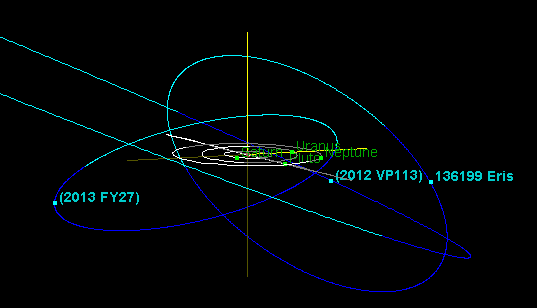Emily Lakdawalla • Apr 02, 2014
More excitement in the outermost solar system: 2013 FY27, a new dwarf planet
On the heels of last week's reports of a second Sedna and a ringed Centaur comes a third cool outer solar system discovery: A new, likely large member of the Kuiper belt. With an absolute magnitude of about 3.0, the new object currently known as 2013 FY27 is the tenth brightest object beyond Neptune (after Eris, Pluto, Makemake, Haumea, Charon, Sedna, 2007 OR10, Orcus, and Quaoar, in that order). We don't know much about it, and translating brightness into size is pretty inexact, but it's a good bet that it's in the neighborhood of 900 kilometers in diameter, plenty big enough to be round: a new dwarf planet.*
FY27 was discovered by Scott Sheppard and Chad Trujillo, in the same survey that yielded VP113, the second Sedna. FY27 is currently about 80 astronomical units from the Sun, similar to VP113's current distance, and therefore one of the most distant currently observable objects in the solar system. Why was there so much fanfare for VP113, but not for FY27?

Remember, what made VP113 unusual wasn't its current distance from the Sun; it was the shape of VP113's orbit and the fact that it never gets closer than about 80 AU from the Sun. A lot of people are getting confused about this, reporting VP113 as the most distant object in the solar system. It isn't; Eris is farther away, and so is Sedna, and so are both Voyagers, and so are known long-period comets (though we can't currently observe those). Both VP113 and FY27 are currently about 80 AU from the Sun, but unlike VP113, the new FY27 is near its aphelion, almost as far away as it ever gets. Over time, FY27's orbit will bring it much closer, to Neptune's neighborhood. As such, while it's an unusually distant object among the things we currently know about, its orbit doesn't stretch the boundaries of our solar system the way VP113 did. Here's a view comparing VP113, FY27, the planets, Pluto, and Eris. FY27's orbit is not like Sedna's; it's more Eris-like.

What makes FY27 special, to me, is its brightness, and implied size. It is almost certainly a round world, and it's a member of a size range of Kuiper belt objects that have really diverse surfaces, implying that each of these worlds has a unique story to tell, variations on themes of ices and organic gunks and transient atmospheres. (Read an article I wrote about Salacia for more about that.) I contacted Scott Sheppard to see if he could tell me anything more about it that wasn't in the MPEC, but there isn't a lot of information on FY27's nature yet. They don't know its color. Still: it's a new round world; it's not every day we add another one of those to our solar system.
Why didn't anyone detect it before? Scott told me that it's because it's fainter than any all-sky survey for trans-Neptunian objects; currently, all-sky TNO surveys have only reached to about 21st magnitude, and FY27 was 22nd magnitude. (He pointed me to this 2011 paper discussing a southern-sky survey that reached to magnitude 21.6.) It's so faint, despite its size, because it's near its aphelion, like Eris and 2007 OR10. That's no coincidence; Kepler's laws of planetary motion tell us that objects in noticeably eccentric orbits spend a lot more time very far from the Sun than they spend very close to the Sun. So all these scattered objects on eccentric orbits are hiding far away, where it's hard to see them; it's only a few rare ones like Sedna and VP113 that just happen to be close enough to us right now for our surveys to detect them.
"That is why we think there are many more large objects out in the inner Oort cloud that Sedna and 2012 VP113 occupy," Scott explained in an email. "Most of these inner Oort cloud objects are going to be near aphelion just like Eris, OR10 and FY27 are in the scattered disk. As the inner Oort cloud aphelion for most objects will be some 500 to 1500 AU out, even Earth-sized objects would not be detected in surveys."
Which means that there are a lot more of these yet to discover. Cool.
...And right after I posted this, Michele Bannister pointed out to me that Sheppard and Trujillo have also found another new object, 2013 FZ27. It's not as bright as FY27 but, at magnitude 4.1, it's highly likely to be a dwarf planet, and in the top 30 brightest trans-Neptunians. Our picture of the solar system changes every day!
*Note: 2013 FY27 has just been automatically added to Mike Brown's list of potential dwarf planets. It's listed with an estimated diameter of only 761 kilometers, but that assumes an albedo of 15%, and if you compare to all the other bodies with similar absolute magnitudes on the list, you'll see that they're darker than that. Assuming an albedo of 9%, like Varda, gives you a diameter closer to 950, and if it's as dark as Salacia, it could be as big as 1500 kilometers. So I think 900 is a conservative estimate here.


 Explore Worlds
Explore Worlds Find Life
Find Life Defend Earth
Defend Earth

